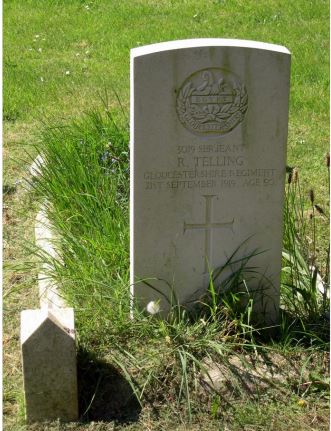3rd Battalion, Gloucestershire Regiment

Raymond George Telling was born in 1869 at Ashton Keynes, Wiltshire, the son of Fred and Sarah Telling.
He was a professional soldier, who spent over 20 years with the colours, having originally enlisted at Cirencester on 22 April 1887, when aged 19 and a labourer. He initially joined the 4th Battalion, Gloucestershire Regiment but the majority of his service was spent with the 2nd Battalion.
According to the Royal Hospital Chelsea Pensioner Soldier Service Records 1760-1920 (National Archive record WO97/1278-4287) he spent the period 22 April 1887 to 2 January 1891 in the UK, followed by a posting to East India until 28 November 1894. There was a further period of UK service until 10 May 1900, before he spent time guarding prisoners on St Helena until 31 January 1902. From there he was posted to South Africa until 18 December 1903, before completing his service in the UK until discharge, having completed a second period of engagement on 21 April 1908. He retired having given ‘exemplary service’ and risen to the rank of sergeant
Unfortunately, his Service Record from the Great War has not survived but the small Pension Record that has survived it confirms that he originally enlisted on 22 April 1887 (age 19) and he was discharged, on a pension of 21 shillings (£1.05) per day for life, on 21 April 1908, when aged 39.
In the 1911 Census return he described his occupation as ‘Army Pensioner and farm labourer’. He had married Alice Fletcher in Bristol on 3 March 1904 and there were no children. The couple lived at Rose Cottage, Waterley Bottom, North Nibley, Dursley.
When war broke out in August 1914 he re-enlisted in the Army, on 15 September 1914, at the age of 45. He probably joined the 3rd Battalion, Gloucestershire Regiment, a reserve battalion formed in Bristol but which spent the remainder of the war in the Medway area of Kent, as a garrison battalion. He has a Medal Rolls Index Card but this does not indicate any overseas service (neither does the surviving Pension papers).
He was discharged from the Army on 5 March 1919. He appears to have been afflicted with a rheumatic illness and he was issued with a Silver War Badge and granted a pension (additional to that from his previous service).
He died on 21 September 1919, aged 50; cause unknown but probably related to the rheumatic condition and was buried in the cemetery at North Nibley. Originally he had a private headstone but the deterioration of the grave over the years prompted the CWGC to install one of their standard headstones on it.
Researched by Graham Adams 21 January 2014
